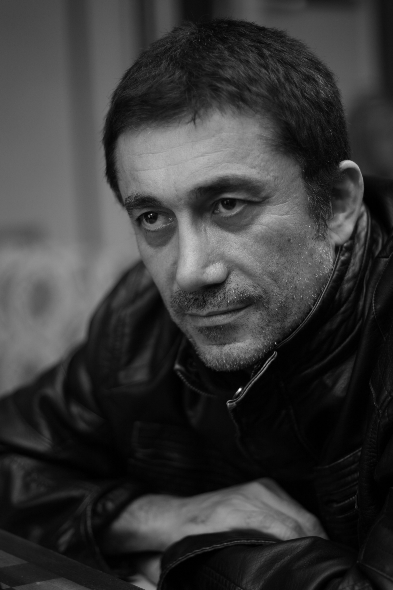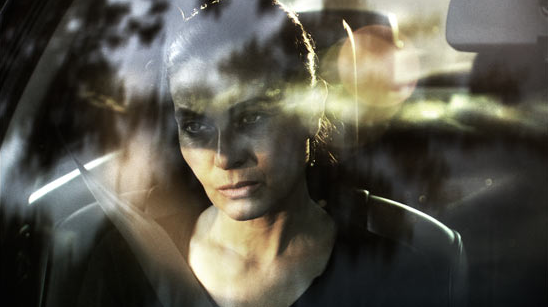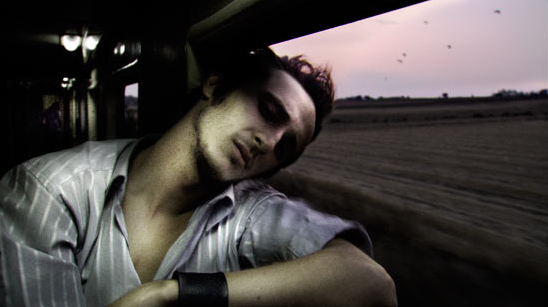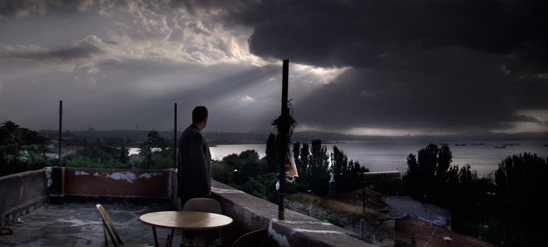Flickering Light:
Impressions of Truth in Ceylan’s Three Monkeys
By Diane Sippl

Nuri Bilge Ceylan
What is life? a fighting
In heart and brain with Trolls.
Poetry? That means writing
Doomsday-accounts of our soul.
— Henrik Ibsen
One of the most challenging and by far most rewarding of films at the 24th Santa Barbara International Film Festival in its highly impressive slate of World Cinema was Three Monkeys. Last year Cannes named Nuri Bilge Ceylan its Best Director. Not only had he made five features in eleven years, but he was picking up his fourth major award at that festival in six years, not counting the two Best Actor awards bestowed on his cast there for Distant (2002). Regardless of his laurels, this Turkish writer-director-editor who has also acted in and produced his own films, not to mention rolling the camera, is one of the leading lights of world cinema. And yet, “Cinema is dead,” we have heard him say, a bit tongue-in-cheek but literally so, because one of the astounding feats of his recent films, Climates (2006) and then Three Monkeys (2008), is his pioneering use of high-definition digital video to the effect that he has, visibly at least, no rival. His traveling photography exhibits, Turkey Cinemascope (2006, 2007) and For My Father (2008, 2009), showcasing the art that was formative in his career as his first love, map new ground in using his cinema technology for the still image, never quite seen like this before.
Critics have deemed Three Monkeys a departure from Ceylan’s previous films marked by more than his camera, and they are suddenly slapping genre labels on his work as if its life depended on it. His latest has been called a Gothic potboiler, a taut thriller, a morbid melodrama, a loopy crime story, or even an expressionistic “neo-noir” — in any case, neo-Ceylan. But don’t be so sure. And surely, don’t be so atavistic as to hang his 21st-century films on age-old pegs fixed by the dime novel, Broadway, and Hollywood. Ceylan is his own man with images: they are etched with his personal legacy and they speak with his singular voice. Its elocution is that of the poet, pure and simple. He plays on the tensions between shades of meaning that billow and gather or slip past each other quietly as clouds. Utterances erupt and dissipate. Reflections pile up and fade. And in the balance time weighs heavily.

Consider his métier beside the
proverb of “the three wise monkeys,” one we know well, or so we think. Ceylan has spoken of it simply as today’s
maxim, “See no evil, hear no evil, speak no evil,” pointing to those who either
dodge involvement or stand distant and aloof from an immoral act in which they
are indeed involved. Yet he also reminds
us that if the adage dates back to the time of Confucius, it was used
affirmatively then. In fact, Nagisa
Oshima, in a 1991 documentary he made about his home town,
It’s both the propriety and the modeling that make for riveting drama in Ceylan’s Three Monkeys, poetic as the film is at its core. The bare-bones progression of events is cyclical. If only Servet (Ercan Kesal) hadn’t been running for public office, he might not have run from the blame for his crime, a car accident in the night with a seeming fatality. If only Eyüp (Yavuz Bingöl), his driver who was at home asleep, hadn’t been so desperate for money for his family, he might not have taken the rap for his boss, Servet. So then if Eyüp had been living at home instead of behind bars for nine months, his son İsmael (Ahmet Rıfat Şungar) wouldn’t have prompted Hacer (Hatice Aslan), his mother, to secure an advance from Servet for İsmael to buy a car for work. If only Hacer hadn’t come begging and Servet hadn’t lost his pride along with the election, he might not have moved on her as a target for seduction outside his marriage. Had he not given her both kinds of “advances,” the money and the attention, and offered her “anything,” Hacer might not have been so dazzled by the power and charisma she saw on his shirtsleeves. So if Hacer could simply have “taken the money and run,” İsmael would not have been privy to her secret affair, and if he hadn’t lied about it to Eyüp in prison, İsmael might not have… If only Servet hadn’t bribed Eyüp, Eyüp might not be bribing Bayram (Cafer Köse), who has nowhere to live.

But we can step back a bit, and we should. If only the little boy (Gürkan Aydın) in their family hadn’t drown some time ago, then Hacer, Eyüp, and İsmael might not feel so guilty and ashamed that they allow themselves to become the pawns of others and turn their backs on the evil within so-called “propriety,” thus extending, expanding, and escalating the cycle as it eats away at the easiest prey, working-class people like themselves or even someone homeless. In any event, the specter of this young boy is a means by which Ceylan’s personal themes — prevalent throughout his oeuvre, subtle as they are — lace Three Monkeys together and stamp it as his work regardless of its seeming departures from his first five, more “autobiographical” films. Distant (2002), Clouds of May (1999), The Small Town (1997), and even his award-winning short film, Cocoon (1995), all feature a dream sequence, a ghost of some kind, often when someone is falling asleep in front of the TV set, or even in the corn field, where there is also mournful talk of the boy that was “lost.” There are the tadpoles fighting the current for their lives in Clouds of May just as a duckling does in the stream of Cocoon; and there is often the egg, rolled across the floor of the photographer’s studio in Distant or hand-held over days in Clouds of May. There is a ledge — a window sill or wall — with a woman on it poised to fall, in either a guilty dream (The Small Town) or night’s shadow (Three Monkeys). There is the theme of deceit: “Do you know what cheating is?” the filmmaker asks little Ali in Clouds of May. “That means tricking someone,” replies the schoolboy, who will soon be tempted himself, in order to gain a musical pocket watch that will resound at inopportune moments. And there is also the listless teen who has failed his exams, a young man without means, drifting, sulking, put-upon, the lies of the others pent up inside him. In previous films he quits a job (The Small Town) or takes off for the city (Distant). In Three Monkeys, he performs a seemingly irreversible action, perhaps the film’s most significant, yet we never see it happen.

In this way Ceylan’s latest film stretches a strategy he’s been developing all along: the elision of the superfluous. With music restricted almost entirely to the isolated, ironic tune of an on-screen source, a sardonically witty cell-phone ring of a woman’s pop song, dialogue is the next to be pared down. Exchanges are terse and either evasive or accusative; often they are disconnected, as are the facial expressions that accompany them. And yet these visages quiver and crease with ignominy. If Chekhov hangs in the air in Ceylan’s earlier work, Three Monkeys is home to Dostoevsky, at least so far as the novelist manifests themes from his personal life in The Brothers Karamazov, such as the loss of his three-year-old son owing to his own inadvertent complicity and also the false conviction of a murderer sentenced to Siberia. If Dostoevsky’s characters are “without skin,” as the Russian filmmaker Andrei Mikhalkov-Konchalovsky noted to me in preparing to stage an opera of Crime and Punishment, Ceylan’s characters proceed as if they have no qualms, yet they live in a sweat of compunction. We watch them lie, spy, and hide all the while they set their own traps and get caught in them. The genius of unspooling the story in this way is that we rarely know more — and may even know less — than the characters themselves. We search their faces for clues to actions that have transpired off-screen.
Ceylan’s aesthetic in Three Monkeys, organically bound up with his themes, is fully pronounced in the brief pre-credit sequence. On an almost totally black screen, a close-up of a man driving a car catches his eyes struggling to stay open. The cut is to his point of view down a dark road obscured but for his headlights. Gradually the black frame closes in on the moving vehicle from all sides and a certain myopia sets in: the car recedes until it vanishes. Screeching brakes from a car we no longer see are heard over a black screen; then a body appears lying on the road. Another car stops just long enough to catch the license plate of the first. Hiding off-screen, the original driver now rises from the bottom of the frame and enters his car. The film cuts to a lingering shot of a winding road glistening silver in the night, a seemingly “empty” frame that is met with a crack of thunder. The tone is there, yes, but more than that, a voyeur’s peeping perception of life, a blinking code for feeling and doing that fades in and out of consciousness, be it waking or sleeping, fair or foul.
Soon thereafter Ceylan delivers key dialogue — the bargain Servet strikes with Eyüp — in a voice-over long before its source is disclosed (while the working man walks to the boss through the night, crossing a tunnel as a train flashes past). When Hacer first enters Servet’s car, Ceylan again plays with speech, this time removing it sporadically from its visible source. A two-shot in Servet’s car offers tender and intimate lines from him to Hacer, but because they only intermittently issue from his visible lips, we have to wonder who is registering them, Servet or Hacer or both.

In the cinemascope format of Three Monkeys, the family apartment looks ribbon-wide, a mere façade of architecture balanced in the frame with a wide line of fencing along the tracks running below. Inside that dwelling, one fixed camera allows glimpses into three cramped rooms at once, each a host for incrimination, unspoken as it may be. Yet a bay window and a long balcony with a view to the sea open the frame to endless layers of images. On occasion, Ceylan’s composition and editing shore up a voyeur’s point of view without ever positing the particular onlooker, though we know who it is. A long shot of Hacer and Servet that is distant enough for us to see a storm gather over the sea and lasting enough for the sky to dim with shadow ultimately lands us with another perspective further back that must be Eyüp’s. Ceylan’s mind itself works like one shrewd nephelometer, precisely determining the suspension of his narrative, its density and its movement, by transmitting and reflecting light. His scenes are as distilled as they are expansive, often delivering palpable texture and sixth-sense aura within the same frame. The real music of Three Monkeys is a round of revolving doors through which each character stumbles and falls, metered and aired by the crash of clouds and of light threatening to shine through.
“A country without cinema, and a history of cinema, is a
house without mirrors,” said Glauber Rocha.
Ceylan shows us
Three Monkeys
Director: Nuri Bilge Ceylan; Producers: Zeynep Özbatur, Fabienne Vonier, Valerio De Paolis, Cemal Noyan, Nuri Bilge Ceylan; Screenplay: Ebru Ceylan, Ercan Kesal, Nuri Bilge Ceylan; Cinematography: Gökhan Tiryaki; Sound: Murat Şenürkmez; Editors: Ayhan Ergürsel, Bora Gökşingöl, Nuri Bilge Ceylan; Art Director: Ebru Ceylan.
Cast: Yavuz Bingöl, Hatice Aslan, Ahmet Rıfat Şungar, Ercan Kesal, Cafer Köse, Gürkan Aydın.
Color, 35mm cinemascope, 109 minutes. In Turkish with English subtitles